The Best Wood Flooring for Dogs
What is the best hardwood floor for dogs?



For pet owners, their dogs become a part of the family that provide love, loyalty, and laughter. But pet owners also know that dogs, especially big dogs, can create some unique challenges when it comes to flooring. One of the questions most frequently asked is what is the best flooring for dogs? This is important to consider when designing your home and keeping ALL your family members in mind. Many people will tell you that laminate or vinyl are the best types of flooring for dogs and carpet is the worst. Which, anyone who has had pets with carpet can tell you that carpet is not the best choice. Cleaning up accidents (which are bound to happen) on carpet is much more labor intensive than simply wiping them up on hardwood floors. It is also a well-known fact that a lot of allergens (especially fur and animal dander) get trapped in the fibers of the carpet, making allergy sufferers suffer even more. With hardwood floors, you just sweep it up and you’re good to go! While there are benefits to laminate and vinyl when it comes to scratch resistance, we recommend hardwood flooring based on its durability, eco-friendliness, beauty and the potential added value to your home.
Do dogs scratch up hardwood floors?
Short answer: yes, they can.
Long answer: any type of flooring you choose will eventually show damage over time – hardwood floors are no exception. You will see scratches, dents, scuff marks, even staining if the floor is not properly maintained. You need to know ahead of time that having pets inside will require more frequent maintenance of your floor. However, there are different types of wood, finishes and ways to protect your floor that will help prevent the frequency and extent of the damage.
What hardwood flooring is best for dogs?
The best option is to choose flooring made from harder species of wood. Some examples of harder species include hickory, hard maple or white oak.
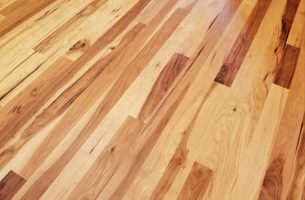
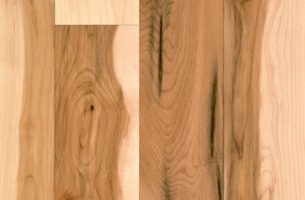

These types of wood are less susceptible to scratches and other damage than softer wood species like black walnut, pine or cherry.


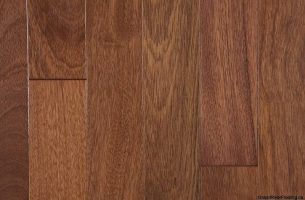
Many species grown in the Northern United States have a shorter growing season which results in trees having closer, more uniform grain – making the wood harder and more durable.
Investing in more scratch-resistant finishes can also help prevent damage to your floors. A finish like UV urethane with aluminum oxide added in will result in a highly scratch-resistance surface. However, too much aluminum oxide can give a cloudy appearance to the floor, covering up the natural beauty of the individual wood planks. It can also result in a plastic-like look. If you want to protect your floors while maintaining the natural look and feel of your wood, then using a natural oil finish is a good option. This type of finish penetrates the wood, creating a molecular bond in the fibers that hardens the wood from the inside out.
Another option is to use prefinished wood floors. Manufacturers can use stronger and more protective finishes in a factory than what can be safely applied on-site. However, when your floor is prefinished, the edges of the planks tend to be slightly beveled, which could result in some of the edges and seams not having protection. This could lead to damage from the ammonia in pet urine. Finishing your floor on-site usually results in seams that are fully sealed, preventing damage on the edges or between the boards.
In additional to harder wood, and strong finishes, you might also want to try camouflaging the damage.
A way to do that is to choose a species with a more pronounced grain pattern. Scratches will blend in with the grain of the wood. Red Oak and Hickory are good choices since they feature more prominent grain patterns.
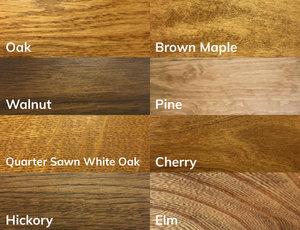
You can also camouflage potential damage to your floor by choosing distressed looking wood. This creates a more rustic look and feel to your home, which is a popular flooring trend in the Southern United States.



How do you protect your hardwood floors from dogs?
Once you’ve chosen the best wood flooring for your dog that fits in with your design plan, a few things to do that will increase the longevity of your hardwood floor are:
- Keep your dog’s toenails clipped
- Not only is this more comfortable for your pup, it will help lower potential scratches on your floor. However, even if you clip their nails, blunt nails on a heavy dog can still do some damage.
- Use rugs in high traffic areas
- If your dog constantly runs to the window to bark at the neighborhood squirrels, it might be a good idea to place a rug in that area. Just make sure the rug doesn’t slide, or your pup will slide with it!
- Place a mat under your dog’s water and food bowls
- This is more to prevent water damage, which might not be an issue depending on the type of wood you have and the finish. But it’s still a good idea!
- Clean up accidents sooner than later
- The ammonia in pet urine can damage finishes and wood. Make sure you clean it up quickly so it doesn’t have time to set in. We will have a post soon about the best way to clean your hardwood floors for animal accidents as well as other day-to-day occurrences. Stay tuned!
***Bonus content***
This post focuses on scratches and other damage that pets can cause – but sometimes we blame our animals for scratches and dents that are actually our fault. From moving furniture incorrectly to having pebbles and other things stuck in the bottom of our shoes. We can be just as guilty of damaging our floors as our dogs. Moral of the story? Take off your shoes!
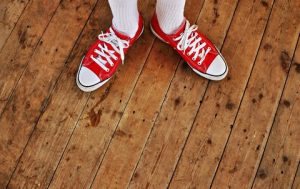
Dogs and hardwood floors CAN go together. It takes a little planning, preventative measures, and maintenance, but there is nothing more peaceful than your pup happily lounging in a ray of sunshine on your beautiful hardwood floor.


